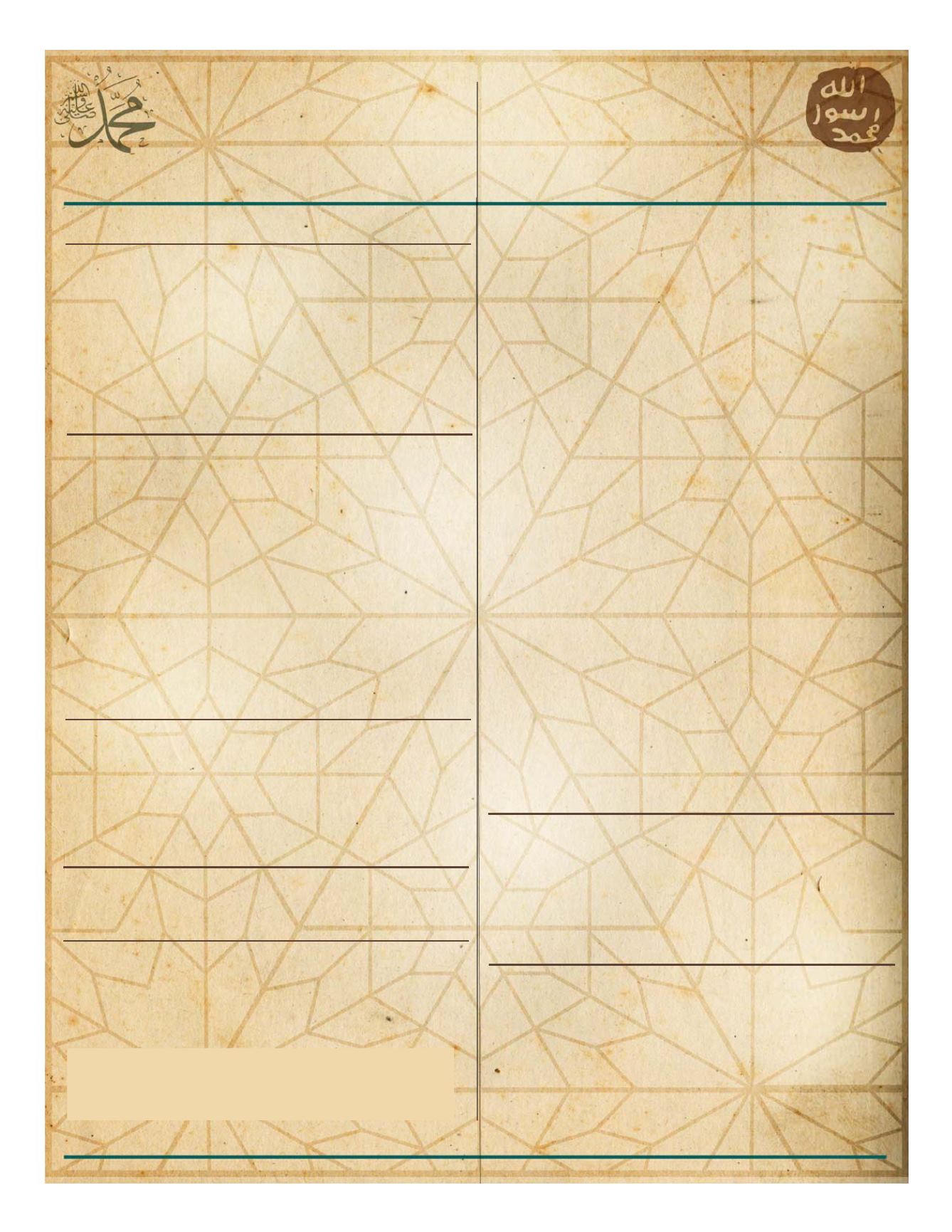

The
of
Sirah
Muhammad
Prophet
The Islamic Bulletin
www.islamicbulletin.org2 of 4
The disbelievers of Quraish gathered in Dar al-Nadwa to plot to kill
the Prophet(S).
The next day, a group of Quraish men surrounded the house of
Prophet(S) in order to assassinate him. When the Prophet(S)
emerged, he threw dust in their direction which temporarily blinded
them. They remained unaware of his exit until morning. At this
point, on the 27th of Safar, the Prophet(S) began the journey of
migration along with his loyal companion Abu Bakr (R.A).
The Prophet(S) stopped in Quba, which was a place at the entrace of
Medina for a few days wherein he established the first masjid, namely
Masjid Quba.
The Jewish rabbis came to the Prophet(S) in order to test him and
determine whether he was their long awaited prophet. Many Jewish
scholars accepted Islam upon meeting him.
The Prophet(S) and his companions (R.A) built Masjid al-Nabawi as
well as his living quarters. As the Muhajirin(Muslims who emigrated to
Medina) had left all their possessions in Makkah, Prophet(S) established the
bond of brotherhood between the Muhajirin and Ansar(Muslims of
Medina). An Ansari took a Muhajir as his brother, which established the
bond of Brotherhood between the Muhajirin and Ansar. The Ansar then
divided his entire wealth with that man whom he had taken as his Brother.
The Athan, call to prayer was established.
As the Quraish prepared to attack Madinah, Allah(SWT) granted the
Muslims permission to defend themselves and thus Jihad was ordained.
Salman al-Farsi and Abdullah bin Salam the famous Jewish
scholar, both accepted Islam.
Fourteenth Year of
Prophethood/First Year of
Migration 622/623 CE
You can also watch or listen to the Sira at our website by clicking link below:
www.islamicbulletin.org/sira/sira.swfclick mouse, wait, click red button,
Thirteenth Year of Prophethood
The second pledge of Aqabah took place, in which 2 women and 70-73
men pledged their allegiance to Prophet(S). The Prophet(S) then appointed
12 leaders amongst them.
Upon seeing the mounting difficulties and persecution the
Muslims faced daily, the Prophet(S) instructed his companions to
migrate to Madinah.
Eleventh Year of Prophethood
The Me’raj/Isra took place wherein the Prophet(S) was taken from
Masjid al-Haram in Makkah, to Masjid al-Aqsa in Palestine in one night. In
this journey, Prophet(S) physically toured the heavens. It was during this
this journey that the 5 daily prayers became obligatory.
Six men from the tribe of Khazraj accepted Islam. Through these six men
Islam began in Yathrib, or as it was later named to, Madinah.
The Prophet(S) married A’isha (R.A).
Twelfth Year of Prophethood
First pledge of Aqabah took place, in which 12 men from Madinah
pledged their allegiance to the Prophet(S).
Seventh-Ninth Years of Prophethood
The Quraish initiated an oppressive boycott to the Muslims and any
supporters of the Propeht(S). To show that it was official, they hung the
charter of the boycott inside the Kabah, with the words, “ In the name of
God.”
The three year long boycott caused massive starvation amongst the
Muslims. They were forced to survive on leaves. Sometimes if they were
lucky they would find skin, which they would roast to eat.
Mansur bin Ikramah, the scribe who drafted the charter of the boycott,
was soon punished by Allah. His hands became disabled and he was never
to write again.
"You have indeed in the Messenger of Allah, a beautiful model
of (conduct) for anyone whose hope is in Allah and the Final
Day and who engages much in the praise of Allah"
Quran: 33 -21.
Tenth Year of Prophethood
The Quraish again asked Abu Talib, to make his nephew stop preaching.
The Propeht(S), by Allah(SWT), said if the Quraish were to find that charter
hanging inside the Kabah was eaten away except for the words, “In the
name of Allah,” then they would stop the boycott. The Quraish found this to
be true and so stopped the boycott.
The Prophet’s (SAW) uncle Abu Talib, who had given him constant
support, and his wife Khadija, with whom he had shared a happy life for
twenty-five years, passed away only three days apart from one another (10
Ramadan/19 April 620). Their demise deeply saddened the Prophet and the
Muslims. Thus, this year came to be known as the Year of Sorrow.
The Prophet(S) went to the city of Taif to ask for help. The people of Taif
mocked and attacked him. On the return from Ta’if an angel asked the
Prophet(S) for permission to crush the people of Ta’if by bringing together
the mountains on either side of the two cities, Prophet(S) refused and
instead prayed for them.
Second Year of Migration
Through the command of Allah the direction of prayer, Qibla, was
changed from Masjid al-Aqsa to Masjid al-Haram.
The Battle of Badr took place between the Muslims and the
disbelievers of Quraish. Despite the fact that the Muslims had only
about 300 ill--equipped men and the Quraish had over a 1000 well armed
men, the Muslims were victorious. The year was 624 C.E.
Fatimah (R.A), the daughter of the Prophet, married Ali (R.A).
Third Year of Migration
The Battle of Uhud took place. The year was 625 C.E.
In this battle, Prophet Muhammed(S) placed fifty of his best archers on the
side of the mountain took protect the Muslims from the rear. They were
instructed not to leave until instructed to do so.
When the Quraysh started retreating, the archers eager to collect the
booty(spoils of the war), started running down the mountain. Abdullah ibn
Jubayr, tried to convince them to stay, but only ten kept their ground, while
the rest left. The Quraysh seeing the archers leaving their posts, advanced
to the Muslims attacking them from their rear.
The Muslims did not win this battle.
timeline, scroll and click on white circle for audio, Media is for watching video.
















